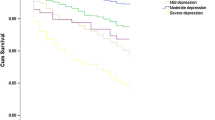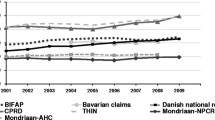Abstract
Objective
To analyse whether first-time use of antidepressants (incidence) and selection of TCAs (tricyclic antidepressants) versus new-generation drugs are associated with socio-economic status and psychiatric history.
Method
We conducted a population-based cohort study using registry data covering Funen County, Denmark. A total of 305,953 adult residents without antidepressant prescriptions 5 years prior to the study period (1998) were included.
Results
The 1-year incidence rate of antidepressant prescription (1.7%) increased with age. It was higher in people who were female, less educated, unemployed, those receiving old-age or disability pension, low-income groups, and singles. The proportion prescribed new-generation antidepressants (82%) showed no difference according to socio-economic variables (education, annual income and socio-economic group), but was higher among the young and single. Admission to psychiatric hospital within 4 years prior to the study period was associated with high-incidence rate of antidepressant prescription and overall a preference for the new-generation antidepressants.
Conclusion
Socio-economic status did not seem to influence the selection of TCAs versus new-generation antidepressants. Compatible with the general epidemiology of depression, low socio-economic status was associated with a high number of first-time users of antidepressants in the population, and the incidence rate increased with age.
Similar content being viewed by others
References
Isacsson G, Boethius G, Henriksson S, Jones JK, Bergman U (1999) Selective serotonin reuptake inhibitors have broadened the utilisation of antidepressant treatment in accordance with recommendations. Findings from a Swedish prescription database. J Affect Disord 53:15–22
Ables AZ, Baughman OL III (2003) Antidepressants: update on new agents and indications. Am Fam Physician 67:547–554
Stevenson FA, Greenfield SM, Jones M, Nayak A, Bradley CP (1999) GPs’ perceptions of patient influence on prescribing. Fam Pract 16:255–261
Kessler RC, McGonagle KA, Zhao S, Nelson CB, Hughes M, Eshleman S et al (1994) Lifetime and 12-month prevalence of DSM-III-R psychiatric disorders in the United States. Results from the National Comorbidity Survey. Arch Gen Psychiatry 51:8–19
Turner RJ, Lloyd DA (1999) The stress process and the social distribution of depression. J Health Soc Behav 40:374–404
Gaist D, Sorensen HT, Hallas J (1997) The Danish prescription registries. Dan Med Bull 44:445–448
Munk-Jorgensen P, Mortensen PB (1997) The Danish psychiatric central register. Dan Med Bull 44:82–84
World Health Organization (1992) The ICD-10 classification of mental and behavioural disorders: clinical descriptions and diagnostic guidelines. WHO, Geneva
Kessing LV (1998) A comparison of ICD-8 and ICD-10 diagnoses of affective disorder—a case register study from Denmark. Eur Psychiatry 13:342–345
Jeynes WH (2002) The challenge of controlling for SES in social science and education research. Educ Psychol Rev 14:205–221
Hansen DG, Søndergaard J, Vach W, Gram LF, Rosholm JU, Kragstrup J (2003) Antidepressant drug use in general practice: inter-practice variation and association with practice characteristics. Eur J Clin Pharmacol 59:143–149
Butler R, Collins E, Katona C, Orrell M (2000) How do general practitioners select antidepressants for depressed elderly people? Int J Geriatr Psychiatry 15:610–613
Isacsson G, Redfors I, Wasserman D, Bergman U (1994) Choice of antidepressants: questionnaire survey of psychiatrists and general practitioners in two areas of Sweden. BMJ 309:1546–1549
Bauer M, Whybrow PC, Angst J, Versiani M, Moller HJ (2002) World Federation of Societies of Biological Psychiatry (WFSBP) guidelines for biological treatment of unipolar depressive disorders, part 1: acute and continuation treatment of major depressive disorder. World J Biol Psychiatry 3:5–43
Lorant V, Deliege D, Eaton W, Robert A, Philippot P, Ansseau M (2003) Socioeconomic inequalities in depression: a meta-analysis. Am J Epidemiol 157:98–112
Eaton WW, Muntaner C, Bovasso G, Smith C (2001) Socioeconomic status and depressive syndrome: the role of inter- and intra-generational mobility, government assistance, and work environment. J Health Soc Behav 42:277–294
Weich S, Lewis G (1998) Poverty, unemployment, and common mental disorders: population based cohort study. BMJ 317:115–119
Horwath E, Johnson J, Klerman GL, Weissman MM (1992) Depressive symptoms as relative and attributable risk factors for first-onset major depression. Arch Gen Psychiatry 49:817–823
Kaplan GA, Roberts RE, Camacho TC, Coyne JC (1987) Psychosocial predictors of depression. Prospective evidence from the human population laboratory studies. Am J Epidemiol 125:206–220
Murphy JM, Olivier DC, Monson RR, Sobol AM, Federman EB, Leighton AH (1991) Depression and anxiety in relation to social status. A prospective epidemiologic study. Arch Gen Psychiatry 48:223–229
Acknowledgements
The study was funded by The Danish Research Foundation for general practice, grant no. 585–148509. We thank Secretary Lise Stark for proofreading the manuscript.
Author information
Authors and Affiliations
Corresponding author
Rights and permissions
About this article
Cite this article
Hansen, D.G., Søndergaard, J., Vach, W. et al. Socio-economic inequalities in first-time use of antidepressants: a population-based study. Eur J Clin Pharmacol 60, 51–55 (2004). https://doi.org/10.1007/s00228-003-0723-y
Received:
Accepted:
Published:
Issue Date:
DOI: https://doi.org/10.1007/s00228-003-0723-y




